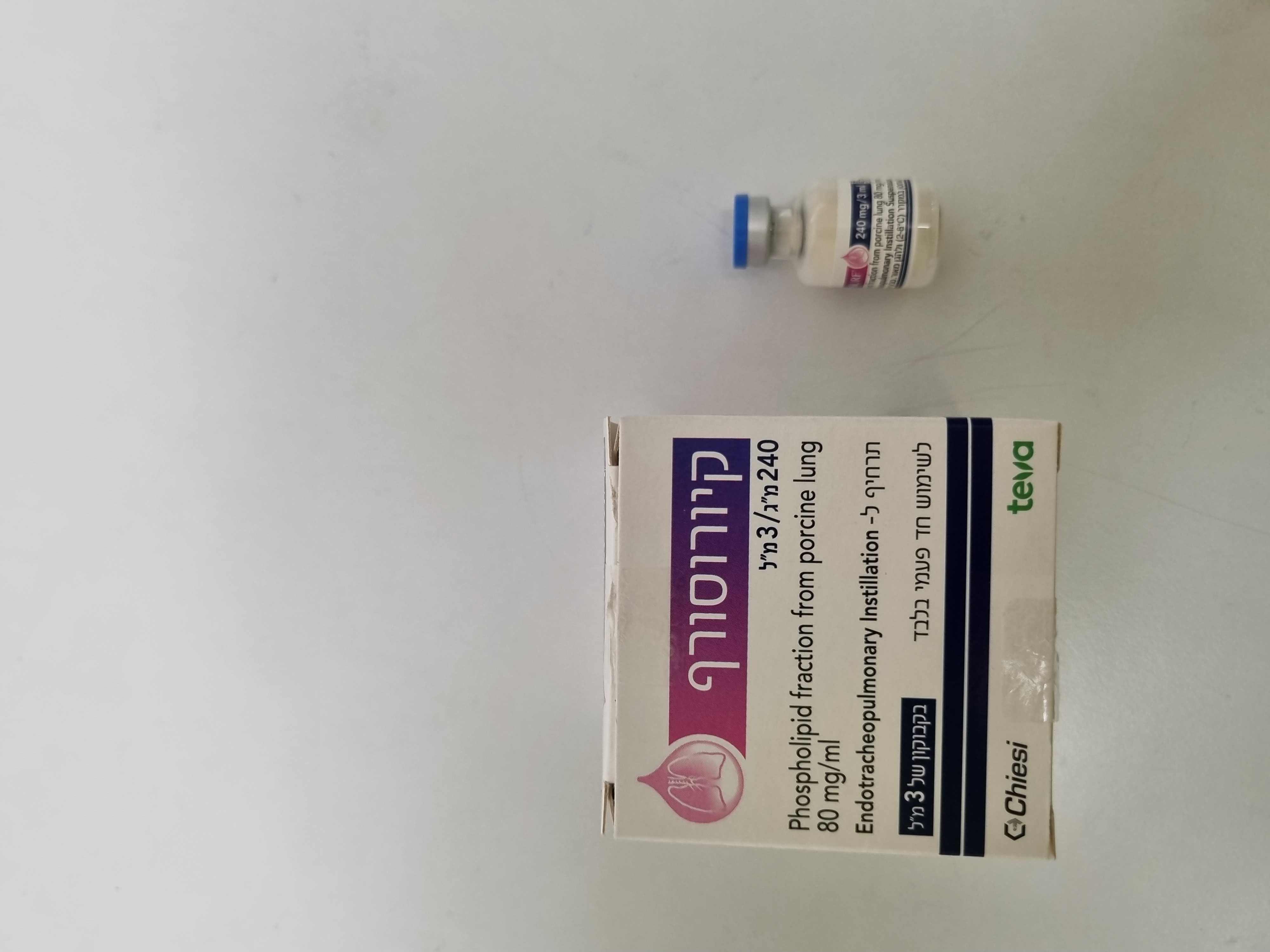Quest for the right Drug

קיורוסורף CUROSURF (PHOSPHOLIPIDS FRACTION FROM PORCINE LUNG)
תרופה במרשם
תרופה בסל
נרקוטיקה
ציטוטוקסיקה
צורת מתן:
לקנה הנשימה והריאה : ENDOTRACHEOPULMONARY INSTILLATION
צורת מינון:
תרחיף : SUSPENSION
עלון לרופא
מינוניםPosology התוויות
Indications תופעות לוואי
Adverse reactions התוויות נגד
Contraindications אינטראקציות
Interactions מינון יתר
Overdose הריון/הנקה
Pregnancy & Lactation אוכלוסיות מיוחדות
Special populations תכונות פרמקולוגיות
Pharmacological properties מידע רוקחי
Pharmaceutical particulars אזהרת שימוש
Special Warning עלון לרופא
Physicians Leaflet
Special Warning : אזהרת שימוש
4.4 Special warnings and precautions for use TREATMENT Prior to starting the treatment with CUROSURF neonates general conditions should be stabilised. Correction of acidosis, hypotension, anaemia, hypoglycaemia and hypothermia is also recommended. In the event of reflux, administration of CUROSURF should be stopped and, if necessary, peak inspiratory pressure should be increased until the obstruction in the endotracheal tube has been cleared. Infants whose ventilation becomes markedly impaired during or shortly after instillation may have mucus plugging the endotracheal tube, particularly if pulmonary secretions were prominent prior to drug administration. Suctioning of infants prior to dosing may lessen the probability of mucus plugs obstructing the endotracheal tube. If endotracheal tube obstruction is suspected, and suctioning is unsuccessful in clearing the obstruction, the endotracheal tube should be replaced immediately. However, aspiration of tracheal secretions is not recommended for at least 6 hours after administration, with the exception of life-threatening conditions. In the event of episodes of bradycardia, hypotension, and reduced oxygen saturation (see section 4.8) administration of CUROSURF should be stopped and suitable measures to normalize heart rate should be considered and undertaken. After stabilisation, the infant can still be treated with appropriate monitoring of vital signs. After administration of CUROSURF pulmonary compliance can improve rapidly, thus requiring prompt reduction of the inspiratory pressure peak without waiting for confirmation from a check of blood gases. The improvement of alveolar gas exchange can result in a rapid increase of arterial oxygen concentration: therefore a rapid adjustment of the inspired oxygen concentration should be made to avoid hyperoxia. In order to maintain proper blood oxygenation values, in addition to periodic blood gas analysis, continuous monitoring of transcutaneous PaO2 or oxygen saturation is also advisable. Nasal continuous positive airway pressure (nasal-CPAP) can be used in maintenance therapy of neonates treated with surfactant, but only in units equipped to perform this technique. New-borns treated with surfactant should be carefully monitored with respect to signs of infection. At the earliest signs of infection the infant should immediately be given appropriate antibiotic therapy. In cases of unsatisfactory response to treatment with CUROSURF or of rapid relapse, it is advisable to consider the possibility of other complications of immaturity such as patent ductus arteriosus or other lung diseases such as pneumonia, before the administration of the next dose. Particular attention must be paid to infants born following a prolonged rupture of the membranes (greater than 3 weeks) since they may have some degree of pulmonary hypoplasia and may not show an optimal response to exogenous surfactant. Surfactant administration can be expected to reduce the severity of RDS but cannot be expected to eliminate entirely the mortality and morbidity associated with preterm birth, as preterm new-borns may present other complications associated with their immaturity. After administration of CUROSURF a transient depression of cerebral-electrical activity lasting from 2 to 10 minutes has been recorded. This has been observed in only one study and its impact is not clear. PROPHYLAXIS Prophylaxis with surfactant should only be performed in facilities which can provide neonatal intensive care with continuous monitoring and treatment in accordance with the following recommendations: a) prophylaxis (within 15 min after birth) should be given to almost all infants under 27 weeks’ gestation; b) prophylaxis should be considered for infants over 26 weeks and under 30 weeks’ gestation if intubation is required in the delivery suite or if the mother has not received prenatal corticosteroids; when prenatal corticosteroids were administered, surfactant should be administered only if RDS develops; c) considering other risk factors, prophylaxis should also be considered in preterm new-borns when any of the following conditions are present: perinatal asphyxia, maternal diabetes, multiple pregnancies, male sex, family history of RDS and caesarean section. In all other preterm neonates it is recommended that surfactant be early administered at the first signs of RDS. There is no information available on effects of initial doses other than 100 or 200 mg/kg, dosing more frequently than every 12 hours, or administration of CUROSURF starting more than 15 hours after diagnosing RDS. The administration of CUROSURF to preterm new-borns with severe hypotension has not been studied. This medicine contains less than 1 mmol sodium (23 mg) per 1 ml, that is to say essentially ‘sodium- free’.
Effects on Driving
4.7 Effects on ability to drive and use machines Not relevant.

שימוש לפי פנקס קופ''ח כללית 1994
לא צוין
תאריך הכללה מקורי בסל
לא צוין
הגבלות
לא צוין
מידע נוסף
עלון מידע לרופא
04.08.22 - עלון לרופאעלון מידע לצרכן
04.08.22 - החמרה לעלוןלתרופה במאגר משרד הבריאות
קיורוסורף